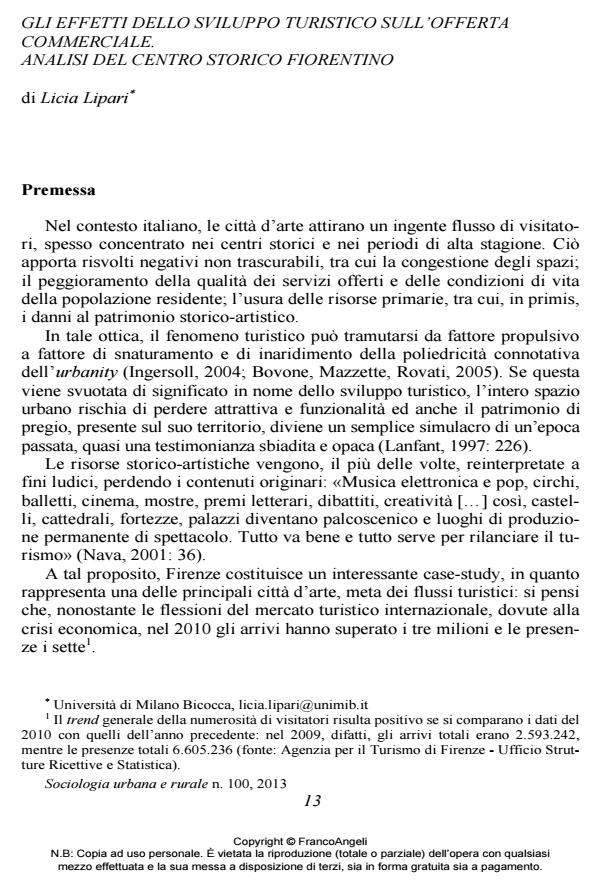The Effects of Tourism Development Upon the Commercial Supply. An Analysis about Historical Center of Florence
Journal title SOCIOLOGIA URBANA E RURALE
Author/s Licia Lipari
Publishing Year 2013 Issue 2013/100 Language Italian
Pages 14 P. 13-26 File size 624 KB
DOI 10.3280/SUR2013-100002
DOI is like a bar code for intellectual property: to have more infomation
click here
Below, you can see the article first page
If you want to buy this article in PDF format, you can do it, following the instructions to buy download credits

FrancoAngeli is member of Publishers International Linking Association, Inc (PILA), a not-for-profit association which run the CrossRef service enabling links to and from online scholarly content.
Tourism is becoming one of the most important economic fields in historical cities. The main consequence is a change in commercial structure. Tourism industry is growing in historical city center, with the risk of the «normal urban activities» displacement. In order to analyze the impact of tourism development, the center of Florence has been chosen on the period 2004-2010. The results show that some areas are exclusively aimed at fulfilling tourists’ demands, other keep a multipurpose function.
Keywords: Commercial Structure, Historical City Center, Tourism, Sustainability, Zoning, Florence.
- Amendola G. (2003). Da città d’arte a Theme Park rinascimentale - il caso di Firenze. In Colantoni M. (a cura di). Turismo: fattore di sviluppo. Bologna: Pàtron
- Becheri E. (1995). Il turismo a Firenze. Firenze: Mercury
- Boffi M. (2004). Scienza dell’informazione geografica. Bologna: Zanichelli
- Butler R.W. (1980). The concept of a Tourism Area Cycle of Evolution: Implications for the Management Resources. Canadian Geographer, n. 24.
- Bovone L., Mazzette A., Rovati A. (2005). Effervescenze urbane. Milano: FrancoAngeli.
- Calvino I. (2010). Le città invisibili. Milano: Mondadori
- Holcomb B. (1999). Marketing Cities for Tourism. In Judd D.R., Fainstein S.S. (eds). The Tourist City. New Haven and London: Yale University Press
- Ingersoll R. (2004). Sprawltown. Cercando la città in periferia. Roma: Meltemi
- Gilli M. (2009). Autenticità e interpretazione nell’esperienza turistica. Milano: FrancoAngeli
- Judd D.R. (1999). Constructing the Tourist Bubble. In Judd D.R., Fainstein S.S. (eds). The Tourist City. New Haven and London: Yale University Press.
- Lanfant M.F. (1997). Tourisme international en prospectives. Sociologia urbana e rurale, n. 52-53.
- Logan J.R., Molotch H. (1987). Urban fortunes: The political economy of place. Berkeley: University of California Press
- Molotch H. (1988). Strategies and Constraints of Growth Elites. In Cummings S. (ed). Business Elites and Urban Development: Case Studies and Critical Perspectives. Albany: State University of New York Press
- Miossec J.M. (1977). Un modèle de l’espace touristique. L’espace géographique, n. 7. DOI: 10.3406/spgeo.1977.1690
- Nava M. (2001). I castelli della Loira dichiarano guerra a Disneyland. In Corriere della Sera, 24/7/2001
- Prud’homme R. (1986). Le Tourisme et le Developpement de Venice. Venezia: Mimeo
- Ritzer G., Liska A. (1997). McDisneyization and Post-Tourism. Complementary perspectives on contemporary tourism. In Rojek C., Urry J. (eds). Touring cultures. London: Routledge
- Savelli A. (2002). Sociologia del turismo. Milano: FrancoAngeli
- Savelli A. (2004). Quando il mondo del turismo interpella la sociologia. In Savelli A. (a cura di). Città, turismo e comunicazione sociale. Milano: FrancoAngeli
- Savelli A. (2008). (a cura di). Spazio turistico e società globale. Milano: FrancoAngeli
- Simmel G. (1973). Firenze. In Cacciari M. (a cura di). Metropolis. Roma: Officina Edizioni
- Timothy D.J., Boyd S.W. (2007). Heritage e turismo. Milano: Hoepli
- Van der Borg J. (1991). Tourism and urban development. Amsterdam: Thesis Publisher
- Van der Borg J., Costa P. (2004). Il turismo a Venezia. Insula Quaderni, n. 20
- Van der Borg J., Gotti G. (1995). Tourism and Cities of Art. Venice: UNESCO ROSTE
- Van der Borg J., Russo A.P. (1998). Per un turismo sostenibile a Venezia. In Musu I. (a cura di). Venezia sostenibile: suggestioni dal futuro. Bologna: il Mulino
- Volpe A. (2004). Il ciclo di vita delle località turistiche. Milano: FrancoAngeli
- Turismo e commercio tra competizione economica e istanze culturali. Il caso della promozione turistica dello shopping a Parigi Chiara Rabbiosi, in ARCHIVIO DI STUDI URBANI E REGIONALI 112/2015 pp.127
DOI: 10.3280/ASUR2015-112007 - Artigianato, città, politiche: il caso di Venezia e della nuova Legge regionale n. 34/20181 Remi Wacogne, Roberto Paladini, in ARCHIVIO DI STUDI URBANI E REGIONALI 130/2021 pp.27
DOI: 10.3280/ASUR2021-130002
Licia Lipari, Gli effetti dello sviluppo turistico sull’offerta commerciale. analisi del centro storico fiorentino in "SOCIOLOGIA URBANA E RURALE" 100/2013, pp 13-26, DOI: 10.3280/SUR2013-100002